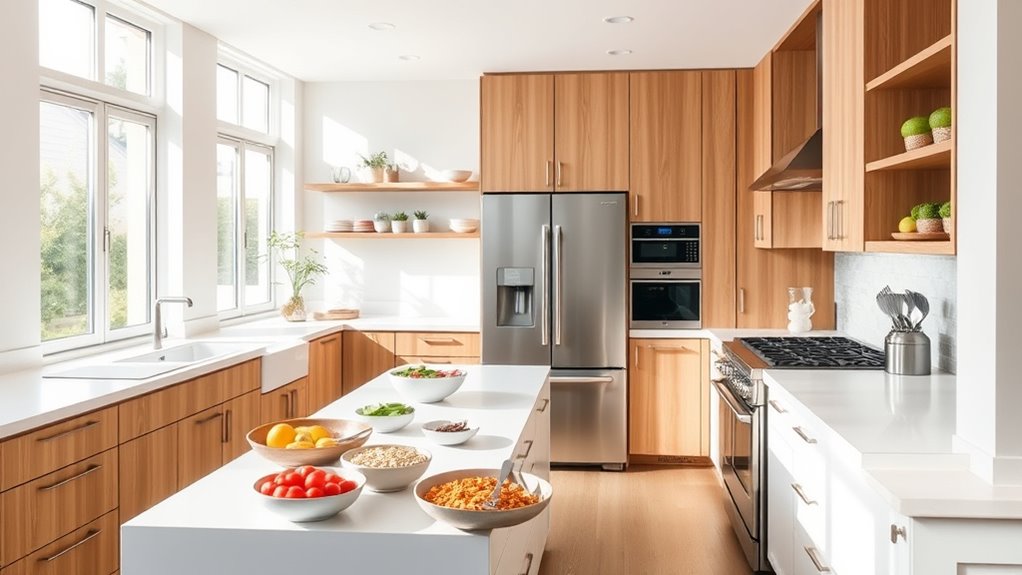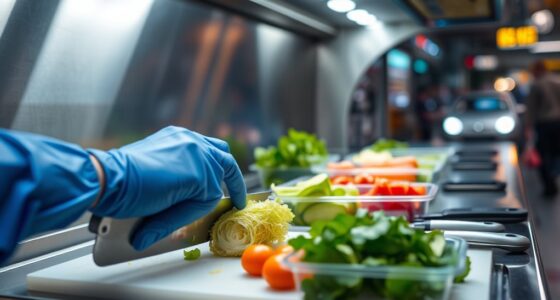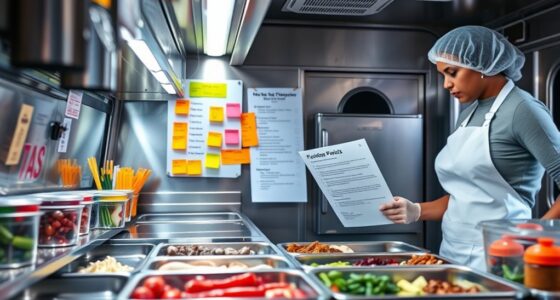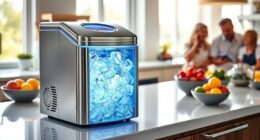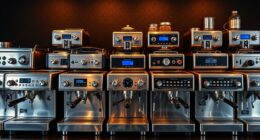To create an allergen-friendly cooking space, start by evaluating your kitchen for cross-contact risks and organizing ingredients with clear labels and separation. Designate specific zones with dedicated tools and storage to prevent contamination. Choose safe, non-allergenic cookware and maintain regular cleaning routines, including proper sanitization. Good ventilation and air purification also help reduce airborne allergens. Stay vigilant with ongoing monitoring and teamwork; if you keep these steps in mind, you’ll find it easier to maintain a safe environment.
Key Takeaways
- Designate specific zones with visual cues and dedicated tools to prevent cross-contact during cooking.
- Organize storage with clear labels, allergen separation, and elevation to reduce contamination risks.
- Use non-allergenic cookware and utensils, maintaining regular cleaning and sanitation routines.
- Implement airtight, labeled containers and separate storage areas for allergen-containing and allergen-free foods.
- Ensure proper ventilation and air purification to minimize airborne allergens and maintain a hygienic environment.
Assessing Your Current Kitchen Setup
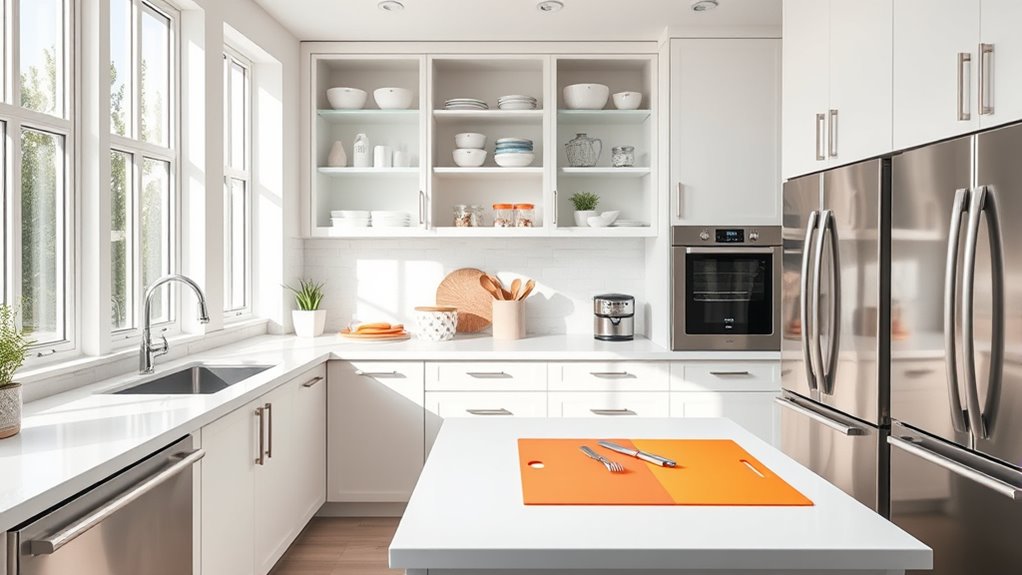
Before making any changes, it’s important to evaluate your current kitchen setup to identify potential allergen risks. Start by examining your kitchen layout to see how space is organized and where cross-contact might occur. Check your storage solutions—are allergen-containing ingredients stored separately from safe foods? Look for clutter or shared containers that could lead to accidental exposure. Assess if commonly used appliances, utensils, and surfaces are easily sanitized or if they might harbor allergens. Consider the placement of your pantry, fridge, and prep areas to prevent cross-contamination. Identifying these issues allows you to understand where risks lie and what adjustments are needed, making your kitchen safer for allergen-sensitive cooking. A clear layout and organized storage are key first steps. Additionally, understanding the role of surface materials can help in selecting the best surfaces to minimize allergen buildup and facilitate cleaning. Incorporating automation in cleaning and choosing hygienic surfaces can further improve maintenance and reduce human error in allergen control. Implementing regular cleaning schedules ensures that allergen residues are consistently managed, enhancing overall safety.
Designating Allergen-Free Zones
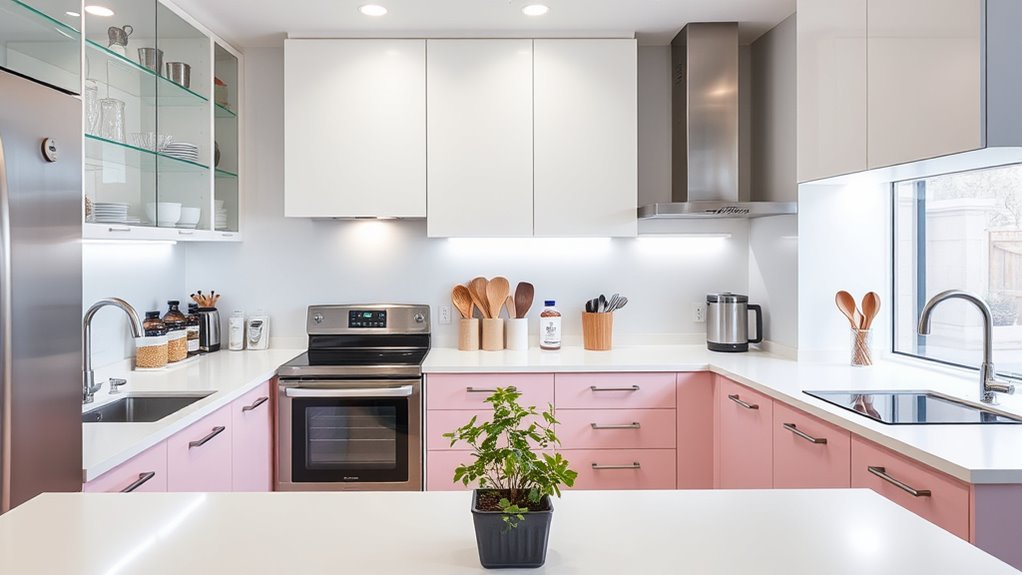
Once you’ve assessed your current kitchen setup, the next step is to create designated allergen-free zones. These zones serve as safety boundaries, helping prevent cross-contact with allergens. Clearly define areas where allergen-free cooking occurs, such as a specific countertop or corner of your kitchen. Use visual cues like signs or color-coded mats to reinforce these boundaries. Keep allergen-free zones stocked with dedicated utensils, cutting boards, and containers to avoid accidental contamination. Communicating these boundaries to everyone in your household is essential, so they understand and respect the safety zones. Regularly monitor and maintain these areas to ensure they remain allergen-free. Incorporating mindfulness techniques can also help you stay attentive to maintaining these safe zones and minimizing risks. Establishing clear allergen-free zones creates a safer environment and gives you peace of mind while cooking.
Choosing and Using Safe Cookware and Utensils
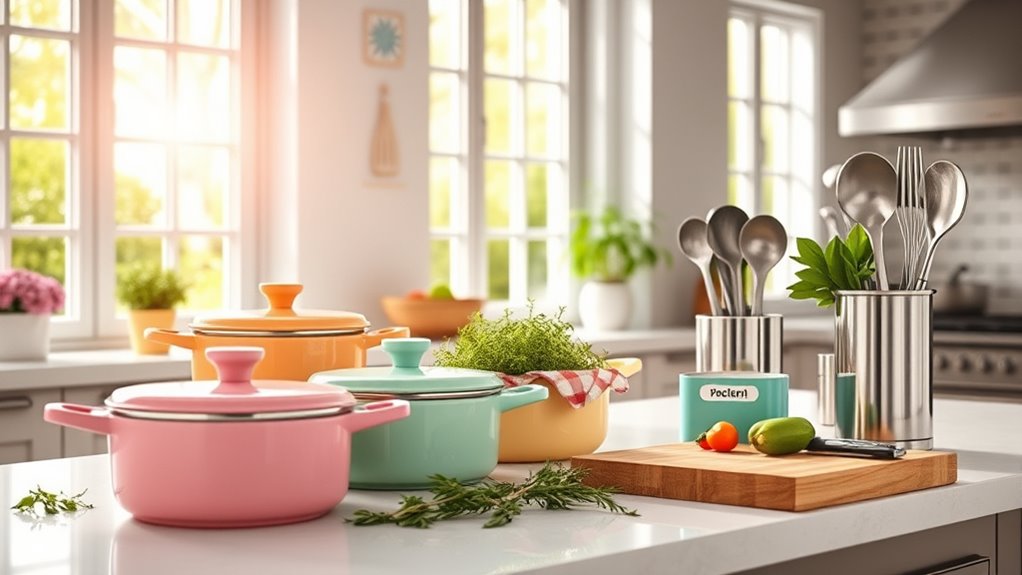
When selecting cookware and utensils, choose non-allergenic materials like stainless steel, glass, or silicone to prevent allergy risks. Keep your tools clean and well-maintained to prevent cross-contamination. Proper care ensures they stay safe and effective for allergen-free cooking. Additionally, ensure your fire safety measures are in place when using any cookware near heat sources to prevent accidents. Using hypoallergenic cookware can further minimize the risk of allergic reactions. Incorporating sustainable materials can also contribute to environmentally friendly cooking practices and reduce exposure to potentially harmful substances. Understanding regional legal resources can help in case you need additional guidance or support for allergy-related safety standards.
Selecting Non‑Allergenic Materials
Choosing non-allergenic cookware and utensils is essential for creating a safe cooking space for allergy sufferers. Opt for materials that minimize allergic reactions and don’t leach harmful chemicals. Consider using cookware made from hypoallergenic countertops like stainless steel, glass, or ceramic. When selecting utensils, choose silicone, bamboo, or other non-reactive materials. Make sure your surfaces are finished with non toxic paint to prevent chemical exposure. To further reduce allergens:
- Avoid non-stick coatings with chemicals like PFOA
- Use utensils free from common allergens like nickel or latex
- Choose cookware labeled as hypoallergenic
- Regularly clean and inspect for residues or damage
- Select vetted cookware and utensils to ensure safety and quality. Additionally, staying informed about regulatory standards can help you choose products that meet safety guidelines and reduce allergen exposure. For optimal safety, regularly check for chemical leaching from cookware surfaces to prevent potential allergic reactions. Incorporating hypoallergenic materials in your kitchen can further minimize the risk of allergic responses and create a truly safe cooking environment. Being aware of manufacturing processes can also help you identify products made with safer, non-reactive components.
Proper Maintenance Practices
Proper maintenance of your cookware and utensils is crucial to ensuring a safe and allergen-free kitchen environment. Regularly clean and thoroughly inspect your tools to prevent cross-contact with allergens. Use dedicated cleaning supplies and avoid harsh chemicals that may leave residues. Staying informed about food allergy awareness helps you identify potential risks and maintain allergen-free surfaces. It’s also essential to have a plan for emergency preparedness, such as knowing how to respond quickly if someone has an allergic reaction. Keep your cookware and utensils separate for different allergens, and replace any that show signs of wear or damage. Proper upkeep minimizes the risk of accidental exposure and promotes a safer cooking space for everyone. Incorporating automation’s role in business intelligence can help you track maintenance schedules and ensure timely inspections, further enhancing safety measures. Additionally, educating yourself about allergen management can aid in creating a comprehensive safety protocol within your kitchen. Regularly updating your knowledge about food allergen labeling helps ensure you are using the safest ingredients and tools, and understanding proper storage techniques can help prevent unintended allergen cross-contact. Implementing proper inventory control can also reduce the chances of using expired or contaminated utensils that might compromise allergen safety.
Implementing Proper Food Storage Practices
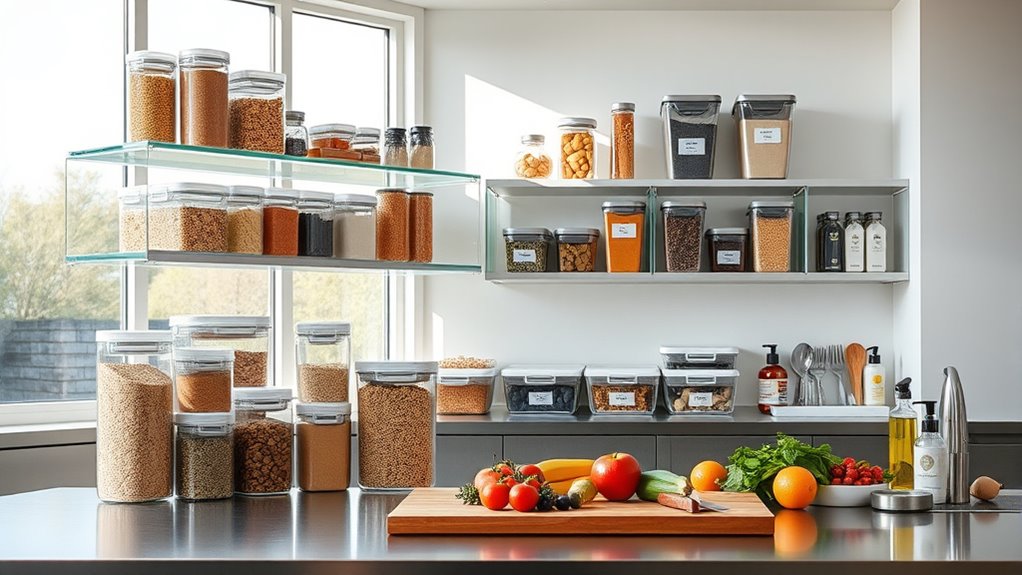
To prevent cross-contamination and keep allergen-free spaces safe, implementing proper food storage practices is essential. Use designated storage containers for different allergen types to avoid mix-ups. Invest in clear, airtight containers to maintain freshness and prevent leaks. Develop a labeling system that clearly identifies each container’s contents and allergen information, so everyone knows what’s inside at a glance. Store allergen-free foods on higher shelves or separate areas to prevent accidental contact. Regularly check expiration dates and discard expired items promptly. Keep raw and cooked foods stored separately to avoid cross-contact. Use color-coded containers or labels to quickly distinguish allergen-safe options from others. Additionally, ensuring proper food storage techniques helps reduce the risk of contamination and promotes a safer kitchen environment. Implementing proper storage methods can also extend the shelf life of your foods, reducing waste and ensuring freshness. Being aware of dog breeds and their specific needs can help in managing a safe environment for everyone, including those with allergies. Paying attention to storage temperature is vital to prevent bacterial growth and spoilage, further safeguarding allergen-free foods. These practices help maintain a safe, organized, and allergen-friendly kitchen environment.
Establishing Cleaning and Sanitizing Routines
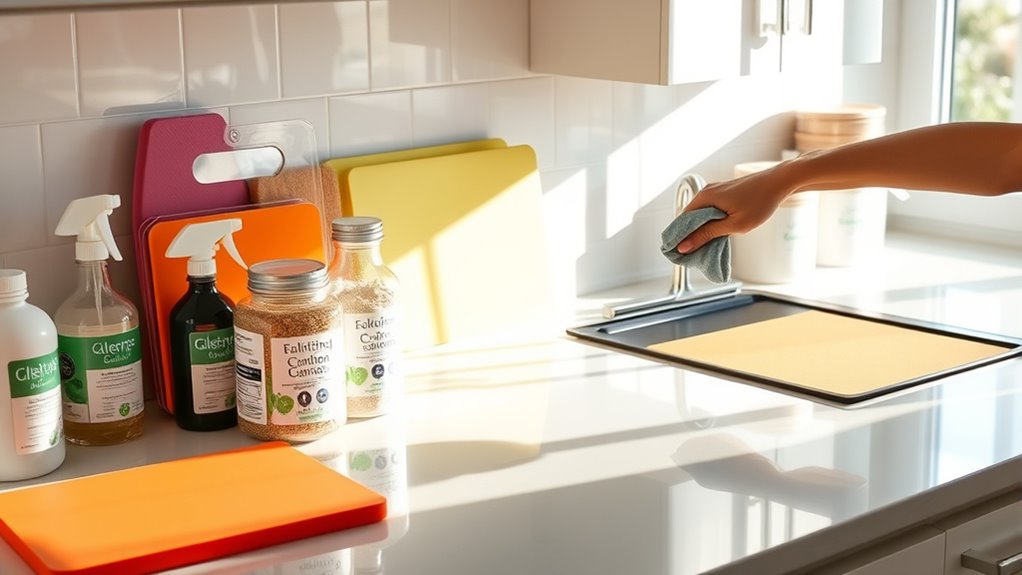
You need to set up a consistent cleaning schedule to keep your space safe. Using proper sanitizing techniques guarantees allergens are effectively removed from surfaces. Staying diligent with these routines helps prevent cross-contact and keeps your kitchen safe for everyone.
Regular Cleaning Schedule
Establishing a regular cleaning schedule is essential for maintaining an allergen-free cooking environment. Consistency helps prevent allergen buildup and supports allergy awareness. To maximize effectiveness, focus on:
- Cleaning surfaces daily to reduce the risk of cross-contact
- Implementing storage optimization by organizing allergen-free ingredients separately
- Sanitizing utensils and tools after each use to avoid contamination
- Scheduling deep cleans weekly to eliminate hidden allergens and maintain hygiene
A well-planned routine ensures allergens are kept at bay, making your space safer for everyone. By staying disciplined with your cleaning schedule, you reinforce allergy awareness and create a healthier cooking environment. Remember, regular cleaning isn’t just about appearance—it’s a key component of allergen management.
Proper Sanitizing Techniques
Proper sanitizing techniques are essential for ensuring that your cooking space remains allergen-free. You should regularly use surface disinfectants on countertops, cutting boards, and utensils to eliminate lingering allergens. After preparing each meal, thoroughly wipe down all surfaces with an effective disinfectant. Keep hand sanitizer nearby and encourage everyone to sanitize their hands before and after handling food. This reduces the risk of cross-contamination. When cleaning, avoid using harsh chemicals that might introduce new allergens; instead, choose products labeled safe for allergy-sensitive environments. Remember, consistent sanitizing not only keeps allergens at bay but also promotes a hygienic cooking space. Incorporate these routines into your daily schedule to maintain a safe and allergen-friendly kitchen.
Organizing Ingredients to Minimize Cross-Contact
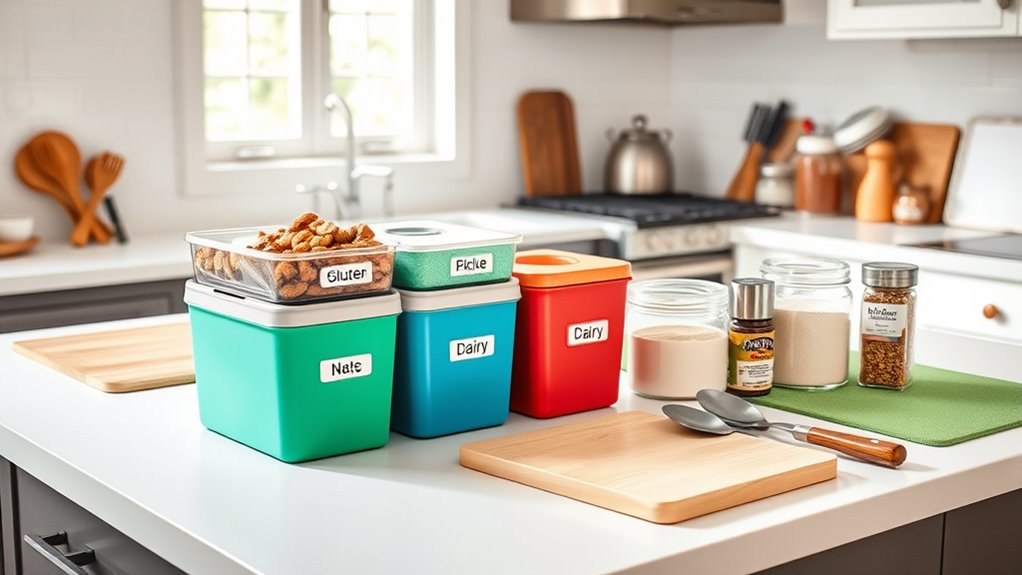
To effectively minimize cross-contact, organizing ingredients methodically is essential. Proper ingredient segregation helps prevent allergens from mixing, reducing the risk of accidental exposure. Use clear, accurate labels to guarantee you can quickly identify allergen-free items and avoid confusion. Keep allergen-containing ingredients separate from safe options at all times. Consider designated storage containers for different allergens, and always check label accuracy before storing or using ingredients. Regularly review your organization system to spot potential cross-contact points. Here are some tips to help:
- Store allergen-free ingredients on separate shelves or containers
- Use color-coded labels for quick identification
- Keep a checklist of allergen-containing items
- Regularly verify label accuracy to prevent errors
Implementing these steps keeps your cooking space safer and reduces cross-contact risks.
Educating Family Members About Allergen Safety
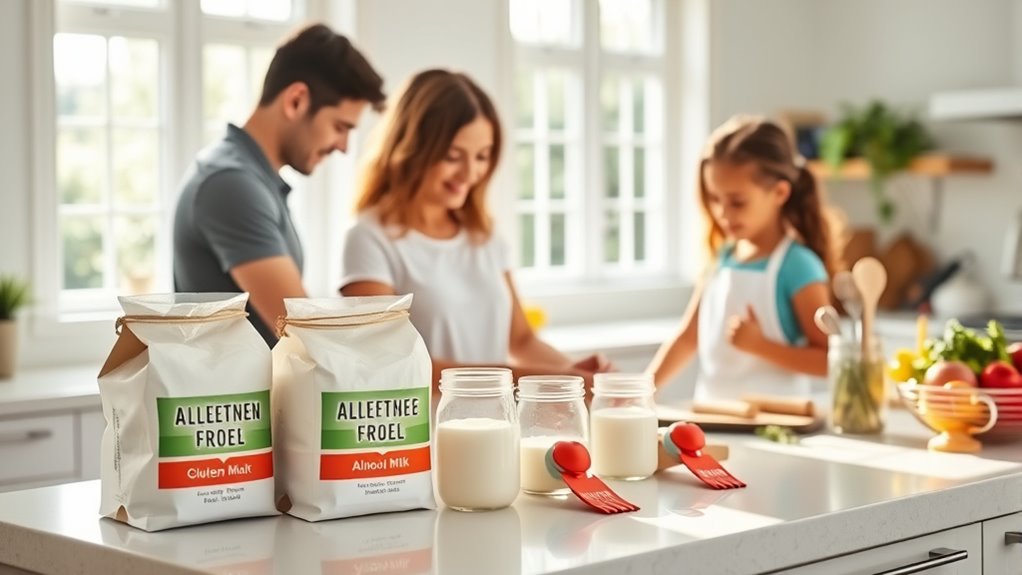
Since everyone in your household plays a role in maintaining allergen safety, it’s crucial to educate family members about allergen labeling and emergency preparedness. Make sure they understand how to read labels carefully to identify potential allergens and avoid cross-contact. Explain the importance of strict communication about food ingredients and shared kitchen tasks. Teach everyone what to do in an emergency, such as recognizing allergy symptoms and how to use an epinephrine auto-injector if needed. Regularly review safety protocols and encourage open discussions about allergen concerns. By fostering awareness and teamwork, you create a safer cooking environment where everyone understands their responsibilities, reducing the risk of accidental allergen exposure and ensuring quick, effective responses to emergencies.
Incorporating Air Purification and Ventilation Solutions
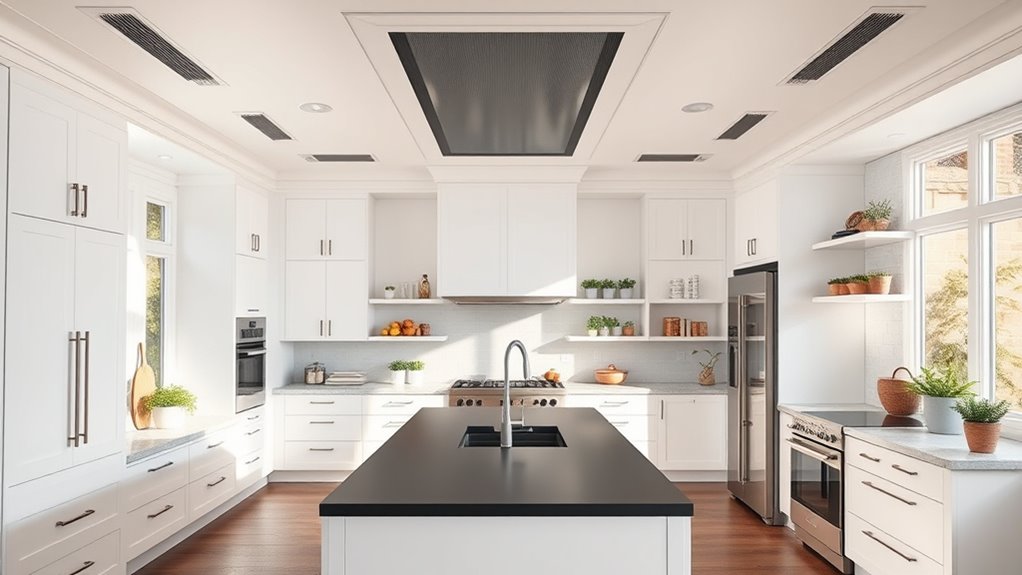
Educating your family about allergen safety sets a strong foundation, but maintaining a truly allergen-friendly kitchen also depends on controlling airborne particles. Good air quality minimizes allergen spread and keeps your space safe. Installing effective ventilation systems helps remove airborne allergens, smoke, and odors quickly. Consider using high-efficiency air purifiers with HEPA filters to trap tiny particles that can trigger reactions. Proper ventilation setup includes:
- Range hoods that vent outside during cooking
- Exhaust fans over stoves and sinks
- Air purifiers placed strategically in the kitchen
- Regular maintenance of vents and filters
These solutions work together to improve air quality and reduce allergen presence. By prioritizing ventilation and air purification, you create a safer, healthier environment for everyone in your allergen-friendly kitchen.
Maintaining Consistency and Monitoring for Safety
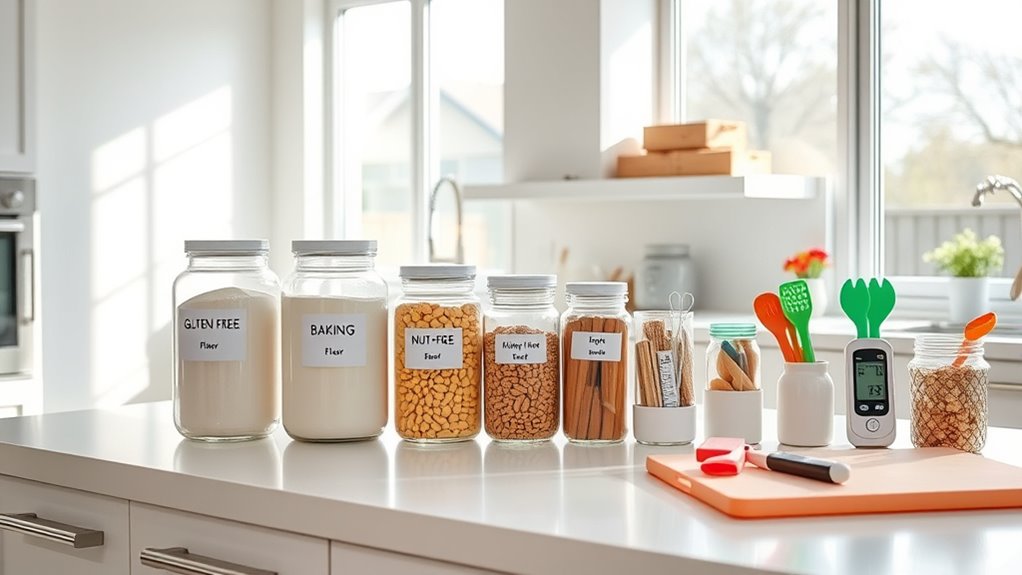
Maintaining a consistent and vigilant approach is vital for guaranteeing ongoing allergen safety in your kitchen. Regularly review and follow your labeling protocols to clearly identify allergen-free ingredients and prepared foods. This prevents cross-contact and confusion during meal prep. Monitoring involves checking that all surfaces, utensils, and equipment remain allergen-free and properly sanitized. It’s also imperative to stay prepared for emergencies by having an action plan in place, including access to emergency contacts and medication like epinephrine auto-injectors. Educate everyone involved about safety procedures and ensure they understand the importance of vigilance. Consistency in these practices minimizes risks and helps create a safe, allergen-friendly environment where everyone can cook and eat with confidence.
Frequently Asked Questions
How Can I Modify My Kitchen for Multiple Allergen Sensitivities?
To accommodate multiple allergen sensitivities, start by implementing kitchen zoning, designating specific areas for allergen-free cooking. Use clear labeling systems on containers and appliances to prevent cross-contact. Keep allergen-rich ingredients separate, and dedicate utensils and tools to each zone. Regularly clean surfaces and storage areas. These steps help you prevent cross-contamination, ensuring a safer environment where you can cook confidently without risking allergen exposure.
What Are the Best Allergen-Free Alternatives for Common Ingredients?
Looking for allergen-free alternatives for common ingredients? You can swap dairy with almond or coconut milk, and use dairy-free cheese or yogurt. For gluten, try rice, quinoa, or gluten-free oats instead of wheat-based products. These options help you enjoy your favorite recipes safely, without sacrificing taste or texture. Incorporate these alternatives into your cooking to accommodate sensitivities and create delicious, allergen-friendly meals effortlessly.
How Do I Handle Eating Out or Food Deliveries Safely?
Hold onto your bonnet—navigating restaurant safety and travel dining today requires vigilance. Always call ahead to confirm allergen protocols and ask about ingredient preparation. When ordering food delivery, specify your allergies clearly and choose reputable establishments. Pack allergy-friendly snacks as backup. Stay alert for cross-contact risks and communicate your needs politely but firmly. These steps help you enjoy eating out safely while managing your allergies effectively.
What Legal or Certification Standards Support Allergen-Free Kitchens?
You should know that FDA regulations set important guidelines for allergen labeling and safety practices. Certification standards, like those from NSF or allergen-free certifications, support you in establishing safe, allergen-free kitchens. These standards help guarantee your space complies with legal requirements, protecting your customers and business. By following these regulations and certification standards, you create a trustworthy environment where allergen safety is prioritized, reducing risks and building customer confidence.
How Can Technology Assist in Managing Allergen Safety at Home?
Think of technology as your vigilant guardian in the kitchen. Smart sensors can monitor environments, alerting you to allergen presence before it becomes a problem. With allergen tracking, you can keep an invisible map of potential dangers, ensuring safe meals for everyone. This high-tech shield empowers you to manage allergen safety at home effortlessly, transforming your space into a fortress where allergy concerns are kept at bay.
Conclusion
By turning your kitchen into a fortress of safety, you create a sanctuary where allergens can’t sneak in unnoticed. With each thoughtful step—designating zones, choosing the right tools, and staying vigilant—you’re weaving a safety net as strong as steel. Keep the rhythm steady, like a well-conducted orchestra, and watch your space transform into a haven of allergen-friendly comfort. Your dedication lights the way to worry-free cooking for everyone at your table.
